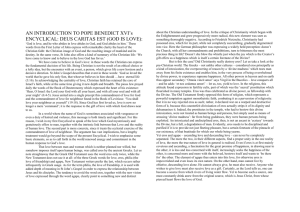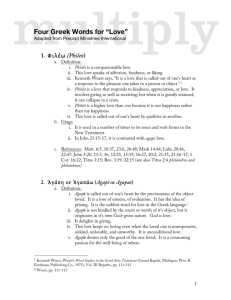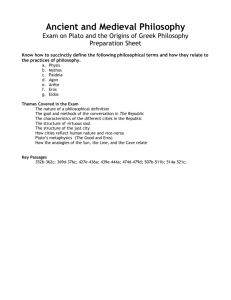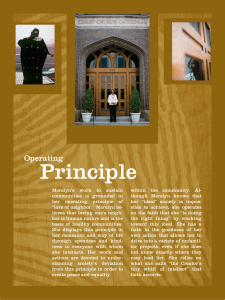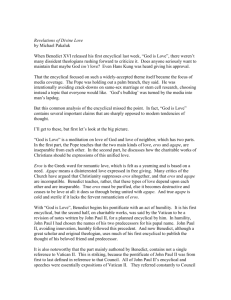Document 15518880
advertisement
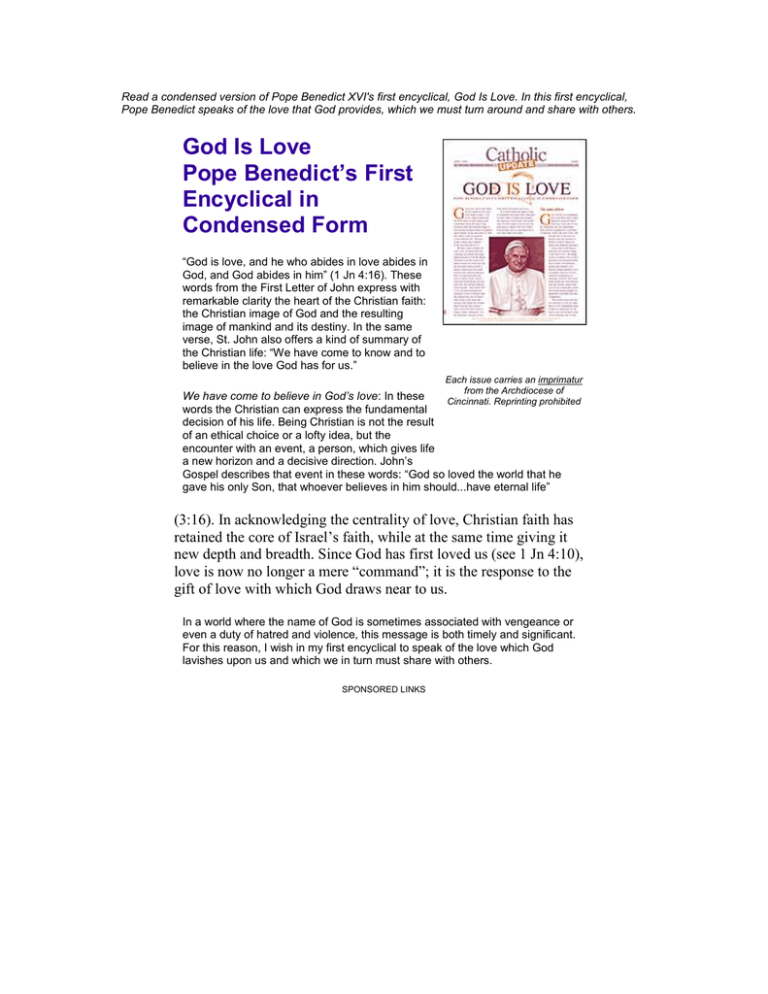
Read a condensed version of Pope Benedict XVI's first encyclical, God Is Love. In this first encyclical, Pope Benedict speaks of the love that God provides, which we must turn around and share with others. God Is Love Pope Benedict’s First Encyclical in Condensed Form “God is love, and he who abides in love abides in God, and God abides in him” (1 Jn 4:16). These words from the First Letter of John express with remarkable clarity the heart of the Christian faith: the Christian image of God and the resulting image of mankind and its destiny. In the same verse, St. John also offers a kind of summary of the Christian life: “We have come to know and to believe in the love God has for us.” Each issue carries an imprimatur from the Archdiocese of We have come to believe in God’s love: In these Cincinnati. Reprinting prohibited words the Christian can express the fundamental decision of his life. Being Christian is not the result of an ethical choice or a lofty idea, but the encounter with an event, a person, which gives life a new horizon and a decisive direction. John’s Gospel describes that event in these words: “God so loved the world that he gave his only Son, that whoever believes in him should...have eternal life” (3:16). In acknowledging the centrality of love, Christian faith has retained the core of Israel’s faith, while at the same time giving it new depth and breadth. Since God has first loved us (see 1 Jn 4:10), love is now no longer a mere “command”; it is the response to the gift of love with which God draws near to us. In a world where the name of God is sometimes associated with vengeance or even a duty of hatred and violence, this message is both timely and significant. For this reason, I wish in my first encyclical to speak of the love which God lavishes upon us and which we in turn must share with others. SPONSORED LINKS The unity of love God’s love for us is fundamental for our lives, and it raises important questions about who God is and who we are. In considering this, we immediately find ourselves hampered by a problem of language. Today, the term “love” has become one of the most frequently used and misused of words, a word to which we attach quite different meanings. Let us first of all bring to mind the vast semantic range of the word “love”: We speak of love of country, love of one’s profession, love between friends, love of work, love between parents and children, love between family members, love of neighbor and love of God. Amid this multiplicity of meanings, however, one in particular stands out: love between man and woman, where body and soul are inseparably joined and human beings glimpse an apparently irresistible promise of happiness. This would seem to be the very epitome of love; all other kinds of love immediately seem to fade in comparison. So we need to ask: Are all these forms of love basically one, so that love, in its many and varied manifestations, is ultimately a single reality, or are we merely using the same word to designate totally different realities? Eros and agape That love between man and woman which is neither planned nor willed, but somehow imposes itself upon human beings, was called eros by the ancient Greeks. Let us note straightaway that the Greek Old Testament uses the word eros only twice, while the New Testament does not use it at all: Of the three Greek words for love—eros, philia (the love of friendship) and agape—New Testament writers prefer the last, which occurs rather infrequently in Greek usage. As for the term philia, the love of friendship, it is used with added depth of meaning in John’s Gospel in order to express the relationship between Jesus and his disciples. The tendency to avoid the word eros, together with the new vision of love expressed through the word agape, clearly points to something new and distinct about the Christian understanding of love. In the critique of Christianity which began with the Enlightenment and grew progressively more radical, this new element was seen as something thoroughly negative. Doesn’t the Church, with all her commandments and prohibitions, turn to bitterness the most precious thing in life? Doesn’t she blow the whistle just when the joy which is the Creator’s gift offers us a happiness which is itself a certain foretaste of the Divine? But is this the case? Did Christianity really destroy eros? Let us take a look at the pre-Christian world. The Greeks—not unlike other cultures—considered eros principally as a kind of intoxication, the overpowering of reason by a “divine madness” which tears man away from his finite existence and enables him, in the very process of being overwhelmed by divine power, to experience supreme happiness. In the religions, this attitude found expression in fertility cults, part of which was the “sacred” prostitution which flourished in many temples. Eros was thus celebrated as divine power, as fellowship with the Divine. The Old Testament firmly opposed this form of religion. But it in no way rejected eros as such; rather, it declared war on a warped and destructive form of it, because this counterfeit divinization of eros actually strips it of its dignity and dehumanizes it. Indeed, the prostitutes in the temple, who had to bestow this divine intoxication, were not treated as human beings and persons, but simply used as a means of arousing “divine madness”: Far from being goddesses, they were human persons being exploited. An intoxicated and undisciplined eros, then, is not an ascent in “ecstasy” towards the Divine, but a fall, a degradation of man. Two things emerge clearly from this rapid overview. First, there is a certain relationship between love and the Divine: Love promises infinity, eternity—a reality far greater and totally other than our everyday existence. Yet we have also seen that the way to attain this goal is not simply by submitting to instinct. Purification and growth in maturity are called for; and these also pass through the path of renunciation. Far from rejecting or “poisoning” eros, they heal it and restore its true grandeur. It is neither the spirit alone nor the body alone that loves: It is man, the person, a unified creature composed of body and soul, who loves. Only when both dimensions are truly united does man attain his full stature. Only thus is love— eros—able to mature and attain its authentic grandeur. Nowadays Christianity of the past is often criticized as having been opposed to the body; and it is quite true that tendencies of this sort have always existed. Yet the contemporary way of exalting the body is deceptive. Eros, reduced to pure sex, has become a commodity, a mere thing to be bought and sold, or rather, man himself becomes a commodity. This is hardly man’s great “yes” to the body. On the contrary, he now considers his body and his sexuality as the purely material part of himself, to be used and exploited at will. Nor does he see it as an arena for the exercise of his freedom, but as a mere object that he attempts, as he pleases, to make both enjoyable and harmless. Here we are actually dealing with a debasement of the human body: No longer is it integrated into our overall existential freedom; no longer is it a vital expression of our whole being, but it is more or less relegated to the purely biological sphere. The apparent exaltation of the body can quickly turn into a hatred of bodiliness. Christian faith, on the other hand, has always considered man a unity in duality, a reality in which spirit and matter compenetrate, and in which each is brought to a new nobility. How might love be experienced so that it can fully realize its human and divine promise? Here we can find a first, important indication in the Song of Songs, an Old Testament book well known to the mystics. According to the interpretation generally held today, the poems contained in this book were originally love songs, perhaps intended for a Jewish wedding feast and meant to exalt conjugal love. By contrast with an indeterminate, “searching” love, ahabà, which the Greek version of the Old Testament translates with the similar sounding agape, expresses the experience of a love which involves a real discovery of the other, moving beyond the selfish character that prevailed earlier. Love now becomes concern and care for the other. No longer is it self-seeking, a sinking in the intoxication of happiness; instead it seeks the good of the beloved: It becomes renunciation and it is ready, and even willing, for sacrifice. The newness of biblical faith The world of the Bible presents us with a new image of God. There is only one God, the Creator of heaven and earth, who is thus the God of all. The one God in whom Israel believes loves with a personal love. His love, moreover, is an elective love: among all the nations he chooses Israel and loves her—but he does so precisely with a view to healing the whole human race. God loves, and his love may certainly be called eros, yet it is also totally agape. This is not only because it is bestowed in a completely gratuitous manner, without any previous merit, but also because it is love which forgives. While the biblical [creation] narrative does not speak of punishment, the idea is certainly present that man is somehow incomplete, driven by nature to seek in another the part that can make him whole, the idea that only in communion with the opposite sex can he become “complete.” The biblical account thus concludes with a prophecy about Adam: “Therefore a man leaves his father and his mother and cleaves to his wife and they become one flesh” (Gn 2:24). Two aspects of this are important. First, eros is somehow rooted in man’s very nature; Adam is a seeker, who “abandons his mother and father” in order to find woman; only together do the two represent complete humanity and become “one flesh.” Second, from the standpoint of creation, eros directs man towards marriage, to a bond which is unique and definitive; thus, and only thus, does it fulfill its deepest purpose. Corresponding to the image of a monotheistic God is monogamous marriage. Marriage based on exclusive and definitive love becomes the icon of the relationship between God and his people and vice versa. God’s way of loving becomes the measure of human love. This close connection between eros and marriage in the Bible has practically no equivalent in extra-biblical literature. Jesus Christ—the incarnate love of God The real novelty of the New Testament lies not so much in new ideas as in the figure of Christ himself, who gives flesh and blood to those concepts—an unprecedented realism. In the Old Testament, the novelty of the Bible did not consist merely in abstract notions but in God’s unpredictable and in some sense unprecedented activity. This divine activity now takes on dramatic form when, in Jesus Christ, it is God himself who goes in search of the “stray sheep,” a suffering and lost humanity. When Jesus speaks in his parables of the shepherd who goes after the lost sheep, of the woman who looks for the lost coin, of the father who goes to meet and embrace his prodigal son, these are no mere words: They constitute an explanation of his very being and activity. His death on the cross is the culmination of that turning of God against himself in which he gives himself in order to raise man up and save him. This is love in its most radical form. By contemplating the pierced side of Christ (see Jn 19:37), we can understand the starting point of this encyclical letter: “God is love” (1 Jn 4:8). It is there that this truth can be contemplated. It is from there that our definition of love must begin. Jesus gave this act of oblation an enduring presence through his institution of the Eucharist at the Last Supper. He anticipated his death and resurrection by giving his disciples, in the bread and wine, his very self, his body and blood as the new manna (see Jn 6:31-33). The ancient world had dimly perceived that man’s real food—what truly nourishes him as man—is ultimately the Logos, eternal wisdom. This same Logos now truly becomes food for us—as love. The imagery of marriage between God and Israel is now realized in a way previously inconceivable: It had meant standing in God’s presence, but now it becomes union with God through sharing in Jesus’ self-gift, sharing in his body and blood. Love can be commanded because it has first been given. This principle is the starting point for understanding the great parables of Jesus. Jesus takes up this cry for help as a warning to help us return to the right path. The Parable of the Good Samaritan (see Lk 10:25-37) offers two particularly important clarifications. Until that time, the concept of “neighbor” was understood as referring essentially to one’s countrymen and to foreigners who had settled in the land of Israel; in other words, to the closely-knit community of a single country or people. This limit is now abolished. Anyone who needs me, and whom I can help, is my neighbor. The concept of “neighbor” is now universalized, yet it remains concrete. Lastly, we should especially mention the great Parable of the Last Judgment (see Mt 25:31-46), in which love becomes the criterion for the definitive decision about a human life’s worth or lack thereof. Jesus identifies himself with those in need, with the hungry, the thirsty, the stranger, the naked, the sick and those in prison. “As you did it to one of the least of these my brethren, you did it to me” (Mt 25:40). Love of God and love of neighbor have become one: In the least of the brethren we find Jesus himself, and in Jesus we find God. Love of God, love of neighbor ‘If anyone says, ‘I love God,’ and hates his brother, he is a liar; for he who does not love his brother whom he has seen, cannot love God whom he has not seen” (1 Jn 4:20). The whole context of the passage quoted from the First Letter of John shows that such love is explicitly demanded. The unbreakable bond between love of God and love of neighbor is emphasized. One is so closely connected to the other that to say that we love God becomes a lie if we are closed to our neighbor or hate him altogether. Here we see the necessary interplay between love of God and love of neighbor which the First Letter of John speaks of with such insistence. Only if I serve my neighbor can my eyes be opened to what God does for me and how much he loves me. The saints—consider the example of Blessed Teresa of Calcutta— constantly renewed their capacity for love of neighbor from their encounter with the Eucharistic Lord, and conversely this encounter acquired its realism and depth in their service to others. Love of God and love of neighbor are thus inseparable; they form a single commandment. Love grows through love. Love is “divine” because it comes from God and unites us to God; through this unifying process it makes us a “we” which transcends our divisions and makes us one, until in the end God is “all in all” (1 Cor 15:28). Charity: a responsibility of the Church Love of neighbor, grounded in the love of God, is first and foremost a responsibility for each individual member of the faithful, but it is also a responsibility for the entire ecclesial community at every level: from the local community to the particular Church and to the Church universal in its entirety. As a community, the Church must practice love. As the years went by and the Church spread further afield, the exercise of charity became established as one of her essential activities, along with the administration of the sacraments and the proclamation of the Word: Love for widows and orphans, prisoners, and the sick and needy of every kind, is as essential to her as the ministry of the sacraments and preaching of the gospel. The Church cannot neglect the service of charity any more than she can neglect the sacraments and the Word. Prayer, as a means of drawing ever new strength from Christ, is concretely and urgently needed. People who pray are not wasting their time, even though the situation appears desperate and seems to call for action alone. Piety does not undermine the struggle against the poverty of our neighbors, however extreme. Faith, hope and charity go together. Hope is practiced through the virtue of patience, which continues to do good even in the face of apparent failure, and through the virtue of humility, which accepts God’s mystery and trusts him even at times of darkness. Faith tells us that God has given his Son for our sakes and gives us the victorious certainty that it is really true: God is love! Love is possible, and we are able to practice it because we are created in the image of God. To experience love and in this way to cause the light of God to enter into the world—this is the invitation I would like to extend with the present encyclical. This condensation is provided to introduce you to the full encyclical, which can be found in Catholic bookstores or online at http://www.vatican.va/. NEXT: Mary Magdalene (by Carol Ann Morrow)


